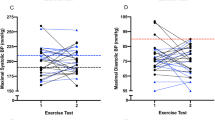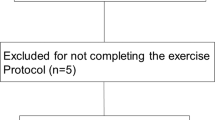Abstract
An exaggerated SBP response to exercise has been associated with increased left ventricular (LV) mass in some but not all studies. A total of 43 women and 34 men, aged 55–75 years, without evidence of cardiovascular disease, with a mean resting BP of 142±9/77±8 mmHg had their BP measured at rest and during maximal treadmill exercise. LV mass was measured using magnetic resonance imaging. LV mass was adjusted for lean body mass, which was assessed by dual energy X-ray absorptiometry. LV mass was within the normal range for the majority of the subjects. Among the resting and exercise BP indices, maximal SBP was the strongest correlate of LV mass (r=0.41, P<0.05). In multivariate analysis, maximal SBP was independently associated with LV mass after adjustment for lean body mass and gender, explaining 3% of the variance (P<0.05). Maximal exercise SBP is a modest but still independent predictor of LV mass in older persons with normal LV mass. These results raise the possibility that the SBP response to maximal exercise is an early marker of LV hypertrophy.
This is a preview of subscription content, access via your institution
Access options
Subscribe to this journal
Receive 12 digital issues and online access to articles
$119.00 per year
only $9.92 per issue
Buy this article
- Purchase on Springer Link
- Instant access to full article PDF
Prices may be subject to local taxes which are calculated during checkout
Similar content being viewed by others
References
Lorell BH, Carabello BA . Left ventricular hypertrophy: pathogenesis, detection, and prognosis. Circulation 2000; 102: 470–479.
Levy D et al. Prognostic implications of echocardiographically determined left ventricular mass in the Farmingham Heart Study. N Engl J Med 1990; 322: 1561–1566.
Koren MJ et al. Relation of left ventricular mass and geometry to morbidity and mortality in uncomplicated essential hypertension. Ann Intern Med 1991; 114: 345–352.
Devereux RB et al. Relations of left ventricular mass to demographic and hemodynamic variables in American Indians: the Strong Heart Study. Circulation 1997; 96: 1416–1423.
Matthews CE et al. Exaggerated blood pressure response to dynamic exercise and risk of future hypertension. J Clin Epidemiol 1998; 51: 29–35.
Singh JP et al. Blood pressure response during treadmill testing as a risk factor for new-onset hypertension. The Farmingham heart study. Circulation 1999; 99: 1831–1836.
Miyai N et al. Blood pressure response to heart rate during exercise test and risk of future hypertension. Hypertension 2002; 39: 761–766.
Manolio TA et al. Exercise blood pressure response and 5-year risk of elevated blood pressure in a cohort of young adults: the CARDIA study. Am J Hypertens 1994; 7: 234–241.
Filipovsky J, Ducimetiere P, Safar ME . Prognostic significance of exercise blood pressure and heart rate in middle-aged men. Hypertension 1992; 20: 333–339.
Fagard RH, Pardaens K, Staessen JA, Thijs L . Prognostic value of invasive hemodynamic measurements at rest and during exercise in hypertensive men. Hypertension 1996; 28: 31–36.
Mundal R et al. Exercise blood pressure predicts cardiovascular mortality in middle-aged men. Hypertension 1994; 24: 56–62.
Molina L, Elosua R, Marrugat J, Pons S . Relation of maximum blood pressure during exercise and regular physical activity in normotensive men with left ventricular mass and hypertrophy. MARATHOM Investigators. Medida de la Actividad fisica y su Relacion Ambiental con Todos los Lipidos en el HOMbre. Am J Cardiol 1999; 84: 890–893.
Karjalainen J, Mantysaari M, Viitasalo M, Kujala U . Left ventricular mass, geometry, and filling in endurance athletes: association with exercise blood pressure. J Appl Physiol 1997; 82: 531–537.
Markovitz JH et al. Lack of independent relationships between left ventricular mass and cardiovascular reactivity to physical and psychological stress in the Coronary Artery Risk Development in Young Adults (CARDIA) Study. Am J Hypertens 1996; 9: 915–923.
Olga V et al. Blood pressure response to stress tests does not reflect blood pressure variability and degree of cardiovascular involvement in young hypertensives. Int J Cardiol 1995; 48: 303–310.
Fagard R, Staessen J, Thijs L, Amery A . Relation of left ventricular mass and filling to exercise blood pressure and rest blood pressure. Am J Cardiol 1995; 75: 53–57.
Cardillo C et al. Relation of stress testing and ambulatory blood pressure to hypertensive cardiac damage. Am J Hypertens 1996; 9: 162–170.
Majahalme S et al. Intra-arterial blood pressure during exercise and left ventricular indices in normotension and borderline and mild hypertension. Blood Press 1997; 6: 5–12.
The Sixth Report of the Joint National Committee on Prevention, Detection, Evaluation, and Treatment of High Blood Pressure. National Institutes of Health-NHLBI: Bethesda MD: Report No.: 98–4080, National High Blood Pressure Education Program; November 1997.
Pate R et al. Physical activity and public health. A recommendation from the Centers for Disease Control and Prevention and the American College of Sports Medicine [see comments]. [Review] [85 refs] Comment in: JAMA 1995 274: 533; discussion 535, Comment in: JAMA 1995 274: 533–534; discussion 535, Comment in: JAMA 1995 Aug 16; 274: 534–535. JAMA 1995; 273: 402–407.
Mosteller RD . Simplified calculation of body-surface area. N Engl J Med 1987; 317: 1098.
Sung J et al. Peripheral endothelium-dependent flow-mediated vasodilatation is associated with left ventricular mass in older persons with hypertension. Am Heart J 2002; 144: 39–44.
MacGowan GA et al. Noninvasive measurement of shortening in the fiber and cross-fiber directions in the normal human left ventricle and in idiopathic dilated cardiomyopathy. Circulation 1997; 96: 535–541.
Borg G . Simple ratings for estimation of perceived exertion. In: Borg G (ed). Physical Work and Effort. Pergamon Press: New York, NY, 1975, pp 39–46.
Casale PN et al. Value of echocardiographic measurement of left ventricular mass in predicting cardiovascular morbid events in hypertensive men. Ann Intern Med 1986; 105: 173–178.
Grossman E et al. Left ventricular mass in hypertension: correlation with casual, exercise and ambulatory blood pressure. J Hum Hypertens 1994; 8: 741–746.
Roman MJ et al. Impact of arterial stiffening on left ventricular structure. Hypertension 2000; 36: 489–494.
Lehmann M, Keul J . Sympatho-vagal changes induced by physical training in cardiac patients. Eur Heart J 1988; 9 (Suppl F): 55–61.
Esler M . The sympathetic system and hypertension. Am J Hypertens 2000; 13: 99S–105S.
Author information
Authors and Affiliations
Corresponding author
Additional information
This study was supported by NIH/NHLBI HL59164 (Dr Stewart) and NCRR M01RR02715 (Johns Hopkins Bayview General Clinical Research Center)
Rights and permissions
About this article
Cite this article
Sung, J., Ouyang, P., Silber, H. et al. Exercise blood pressure response is related to left ventricular mass. J Hum Hypertens 17, 333–338 (2003). https://doi.org/10.1038/sj.jhh.1001552
Published:
Issue Date:
DOI: https://doi.org/10.1038/sj.jhh.1001552



